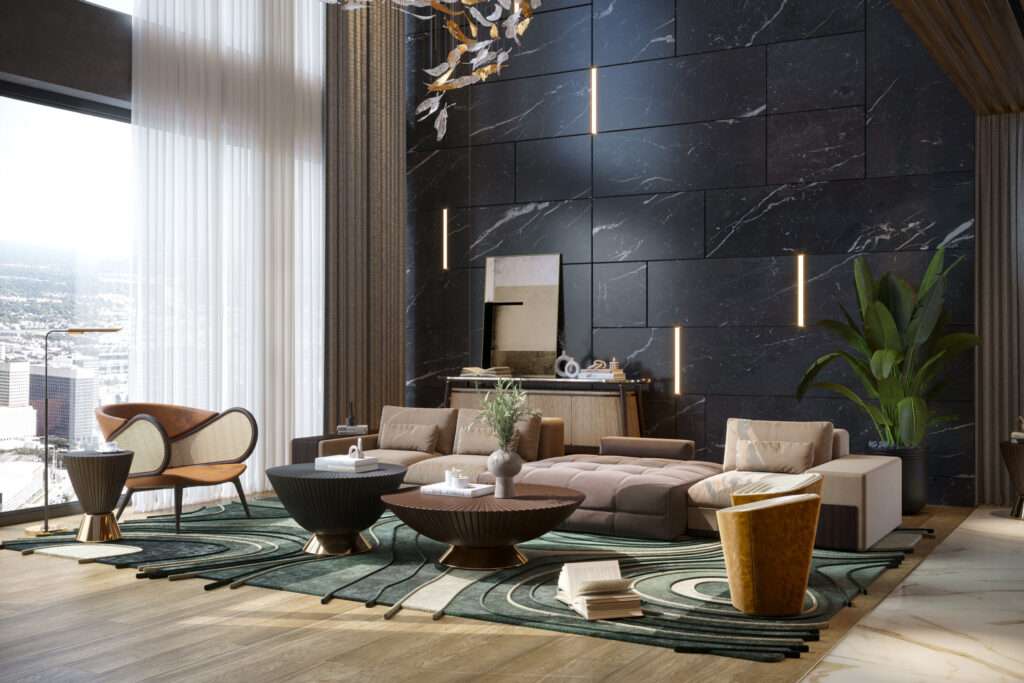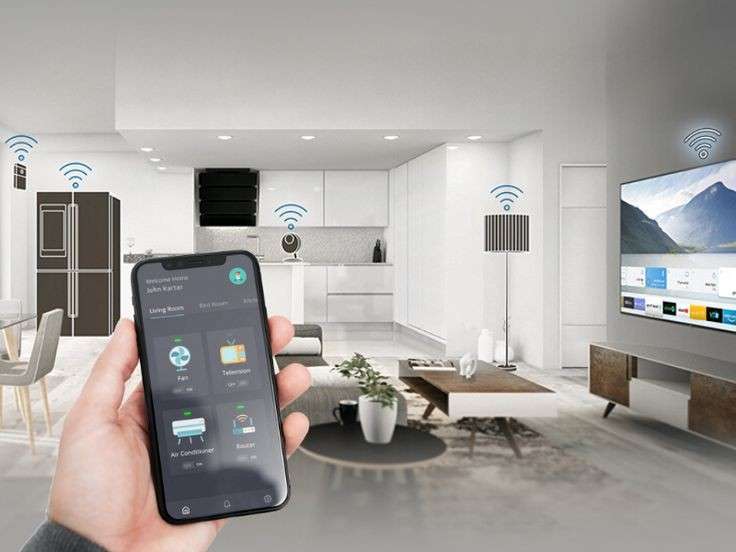Interior design is often thought of as visual art—color palettes, furniture arrangements, and lighting are all essential aspects of creating a beautiful space. But have you ever considered how a space feels, smells, or sounds? In reality, a truly well-designed interior engages all of the senses, creating an environment that goes beyond looks and contributes to an overall sense of well-being. At Scale & Structure, we understand that designing for the senses is a vital aspect of creating spaces that are both functional and comforting.
In this blog, we’ll explore the importance of tactile and sensory elements in interior design, and how incorporating textures, sounds, scents, and other sensory experiences can enhance the atmosphere of your space.

Why Designing for the Senses Matters
Humans interact with their environment in a way that goes beyond what they see. The feel of a chair, the scent in the air, the sounds in the room—all these elements influence our experience of a space. In fact, research shows that sensory design can significantly impact emotions, behavior, and even productivity.
When all the senses are considered, a space becomes more immersive, inviting, and harmonious. Designing for the senses creates an atmosphere that can be calming, stimulating, or inspiring—depending on the intended purpose of the space.
At Scale & Structure, we take a holistic approach to design by considering how a space feels, sounds, smells, and even tastes. Whether it’s a cozy living room, a serene bedroom, or a functional office, integrating sensory elements is key to creating spaces that engage and delight.
Tactile and Sensory Elements in Interior Design
1. Texture: Creating a Tactile Experience
Texture plays an essential role in interior design, as it influences how we physically interact with a space. From the soft touch of a velvet cushion to the smoothness of marble countertops, texture can evoke feelings of comfort, luxury, or even excitement. It also helps to define a space’s character, balancing different design elements and adding depth to the overall design.
How to Incorporate Texture into Your Design:
- Soft textiles: Plush pillows, throws, and rugs can transform a space into a cozy retreat. Fabrics like velvet, silk, and cotton create a tactile experience that invites touch and relaxation.
- Natural materials: Incorporate materials like wood, stone, and leather to add earthy textures that create warmth and connection to nature.
- Contrasting textures: Mix hard and soft textures to create dynamic and visually interesting spaces. For example, a sleek leather sofa paired with a fuzzy wool rug offers both contrast and comfort.
- Wall treatments: Textured wallpaper, wood paneling, or fabric-covered walls add dimension to a room and provide an additional layer of sensory engagement.
At Scale & Structure, we use texture thoughtfully to ensure that each room has a multi-layered sensory experience. From the furniture you sit on to the walls around you, every tactile detail is carefully considered.
2. Sound: The Power of Acoustic Design
The sounds in a space can either enhance or detract from the overall ambiance. Whether it’s the gentle hum of background music, the rustle of leaves in an indoor garden, or the soothing flow of a water feature, sound plays an integral role in the sensory experience of a space.
How to Incorporate Sound into Your Design:
- Acoustic treatments: Install sound-absorbing materials such as carpets, curtains, and acoustic panels to reduce noise and create a more peaceful environment. This is especially important in spaces like offices, libraries, or bedrooms where focus and relaxation are key.
- Natural sounds: Bring the outdoors in by incorporating elements that produce natural sounds, such as water features, wind chimes, or even plants that rustle with the breeze.
- Strategic use of music: For spaces that are meant for relaxation or socializing, music can be a powerful tool. Consider built-in speakers or sound systems to create the perfect auditory atmosphere.
By thoughtfully considering acoustics and sound, Scale & Structure ensures that every room has a soundscape that complements the overall mood and function of the space.
3. Scent: The Subtle Art of Aromatherapy
Scent is one of the most powerful sensory triggers. It has the ability to evoke memories, enhance mood, and even improve cognitive function. In interior design, scent can be used to create a welcoming atmosphere, calm nerves, or energize the senses.
How to Incorporate Scent into Your Design:
- Scented candles and diffusers: Choose scents that align with the purpose of the room. For example, lavender for relaxation in a bedroom, citrus for energy in a home office, or woodsy scents for a calming living room.
- Fresh flowers or plants: Incorporating plants such as jasmine, eucalyptus, or basil adds a natural fragrance to your space while also improving air quality.
- Essential oils: For a more customized experience, use essential oil diffusers to create your preferred aroma that complements your space.
At Scale & Structure, we understand that scent is an often-overlooked element in design, but one that can have a profound impact on how a space is perceived. We help our clients select scents that are aligned with their personal tastes and the intended mood of each room.
4. Lighting: Visual and Sensory Impact
Lighting is a crucial part of any interior design, but it also has sensory implications beyond just its ability to illuminate a space. The quality and warmth of light can significantly influence how we feel in a room—whether it’s the soft glow of a bedside lamp or the bright, focused light of a work desk. Lighting also plays a key role in highlighting textures, colors, and other sensory elements in a space.
How to Incorporate Lighting into Your Design:
- Layered lighting: Use a combination of ambient, task, and accent lighting to create depth and interest. Dimmer switches can also help you control the mood of the room throughout the day.
- Natural light: Maximize natural light through large windows, skylights, or glass doors to bring the outdoors in and promote a positive, energized environment.
- Warm lighting: Use warm light bulbs (yellow or soft white) to create a cozy, relaxing atmosphere. Cooler lighting is ideal for workspaces or areas where focus is key.
At Scale & Structure, we ensure that lighting is carefully selected to work with other sensory elements, creating a space that is both visually stimulating and comforting.
5. Taste: Subtle Sensory Integration
While taste is not often a focal point in interior design, incorporating elements that can appeal to the taste buds subtly is a great way to complete the sensory experience. Whether it’s the integration of fresh fruit in a kitchen design or the presence of a small herb garden, there are ways to engage the sense of taste in the space.
How to Incorporate Taste into Your Design:
- Edible plants and herbs: Grow herbs such as mint, basil, or thyme in your kitchen or dining area to encourage the use of fresh ingredients.
- Incorporate culinary elements: Kitchens designed for cooking and entertaining can include high-quality appliances, open shelving for spices, and even areas for tasting wine or gourmet food.
- Complementary décor: Think about the types of food that the space is designed for, such as warm tones for a cozy breakfast nook or modern finishes for an elegant dining area.
At Scale & Structure, we understand that taste is an integral part of the overall sensory experience, especially in spaces like kitchens, dining rooms, and outdoor areas.
Conclusion: Designing for a Full Sensory Experience
Designing for the senses is about creating a space that engages and delights all aspects of the human experience. From the tactile pleasures of textured surfaces to the calming effects of sound and scent, sensory design can transform any space into an immersive and harmonious environment. At Scale & Structure, we believe that every design element—whether it’s the fabric on a sofa, the scent in the air, or the light in a room—plays a role in crafting a space that feels not just beautiful, but truly alive.
By incorporating tactile and sensory elements thoughtfully, we can design spaces that foster comfort, productivity, relaxation, and overall well-being.



